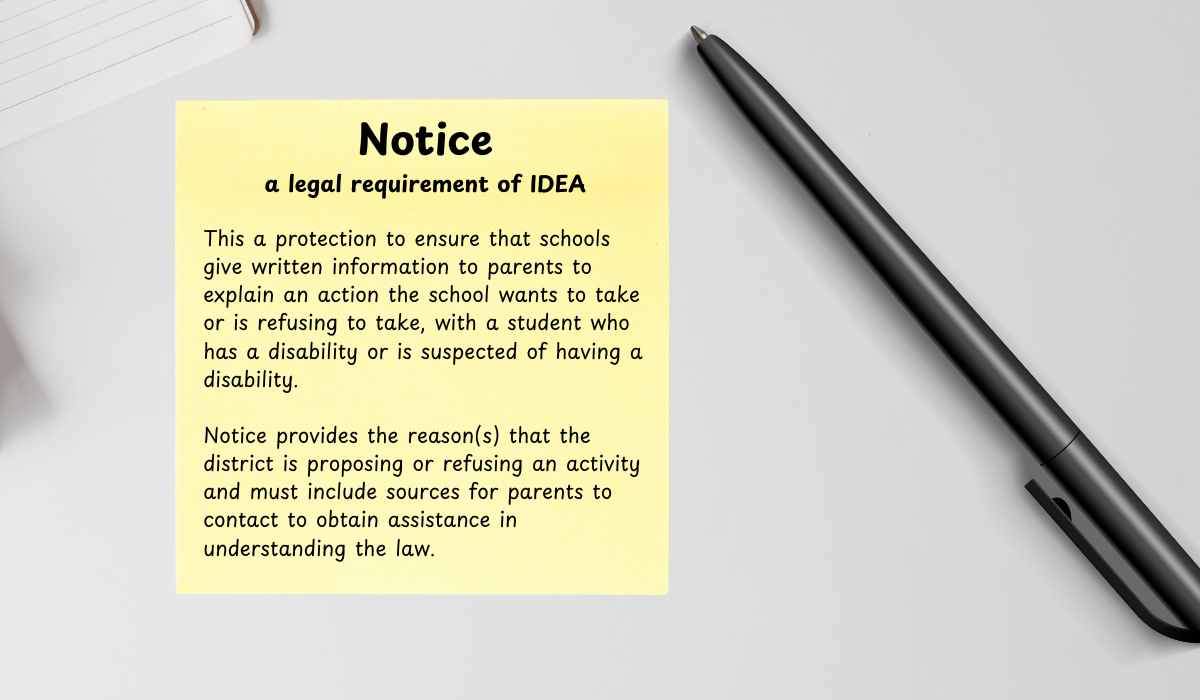Be sure to visit our IEP webpage to see how Notice fit into the IEP process.
IDEA 2004 includes a section called Procedural Safeguards. These safeguards are designed to protect the rights of parents and their child with a disability and, at the same time, give families and school systems mechanisms to resolve their disputes. One of those protections is called “notice”. Notice comes from the district and explains decisions about your child’s education and the reasons/data for making those decisions.
What is “notice”?
Notice (sometimes called Prior Written Notice) is a legal requirement of the Individuals with Disabilities Education Act (IDEA). Notice is provided to the parent by a district to explain an action the district wants to take, or is refusing to take, with a student who has a disability or is suspected of having a disability. Notice provides the reason(s) that the district is proposing or refusing an activity and must include sources for parents to contact to obtain assistance in understanding the law.
School districts must give parents a written notice (information received in writing), whenever the school district:
(1) Proposes to begin or change the identification, evaluation, or educational placement of your child or the provision of a free appropriate public education (FAPE) to your child; or
(2) Refuses to begin or change the identification, evaluation, or educational placement of your child or the provision of FAPE to your child.
What is included in notice?
Notice is an explanation provided when the district wants to take an action, or when the district refuses to take the action. Notice includes information on procedural safeguards and resources for assistance in understanding your rights.
Notice must include these 5 parts:
- A description of the action that the school district proposes or refuses to take
- An explanation of why the school district is proposing or refusing to take that action
- A description of each evaluation procedure, assessment, record, or report the school district used in deciding to propose or refuse the action
- A description of any other choices that the Individualized Education Program (IEP) Team considered and the reasons why those choices were not selected
- A description of other reasons why the school district proposed or refused the action
How can I use notice to better participate in the IEP process?
Always put requests in writing. Throughout your child’s school years, there will be times that you need to communicate with the school system about your child’s education. Put it in writing. If you have a dispute with the school, it’s important to have written documentation to support your position. (More on Documentation and Letter Writing)
- Use the Model Notice Form to ask questions and write down the answers given. (Notice Form- Arabic, Spanish)
- If you don’t receive written notice, ask for it. If you did not receive adequate answers to your questions, say so. Requesting Prior Written Notice (letter template)
Providing written notice is part of your procedural safeguards. If you do not receive notice, your procedural safeguards include the right to file a complaint with the state department of education.
What does this mean in Michigan?
Michigan Department of Education offers these model forms and guidance. Your district may not use these exact forms, but the required 5 pieces of information need to be included in whatever notice looks like in your district.
- Guidance for Notice
- Model Notice Form Notice of Provision of Services and Programs
- Procedural Safeguard Notice
- Guidance for Timeline for Initial Evaluations
What about signing the IEP?
Michigan Administrative Rules for Special Education does not require that parents sign the IEP, except for the first one (called “initial”). If parents disagree with the proposed IEP, there are tools available to resolve the disagreement.


